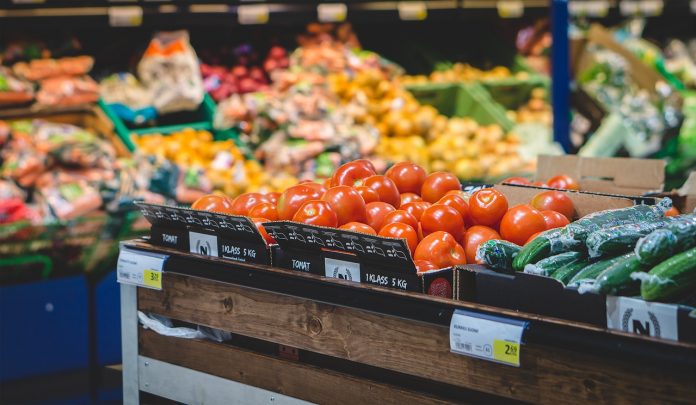By Tracy Turner | Ohio State Chow Line
Q: “What steps do I need to take when grocery shopping in light of the coronavirus pandemic?”
A: COVID-19 is not a foodborne disease. While there have been no reports as of this time to suggest that COVID-19, the disease caused by coronavirus, has been transmitted by handling food or food packaging, here are ways that consumers can protect themselves when grocery shopping.
COVID-19 transmits person-to-person through droplets that are produced when an infected individual coughs or sneezes, said Qiuhong Wang, a scientist and coronavirus researcher with The Ohio State University College of Food, Agricultural, and Environmental Sciences (CFAES).
Common symptoms of COVID-19 include fever, coughing, shortness of breath, and breathing difficulties. Symptoms range from mild to severe respiratory illness. Advanced age or conditions such as various cancers, COPD, asthma, heart disease, and diabetes are associated with an increased severity of COVID-19 infections and fatality rates.
The virus is most often transferred to another individual when droplets directly reach their nose, mouth, or eyes, or through close contact such as a handshake. The virus can also transmit when a person touches an object or surface with the virus on it and then touches their mouth or eyes before washing their hands.
Social Distancing
With that in mind, the most important thing that consumers can do to protect themselves and others when grocery shopping is to practice social distancing, said Sanja Ilic, food safety state specialist with Ohio State University Extension, CFAES’ outreach arm.
That includes keeping at least 6 feet between yourself and other shoppers while shopping and when standing in line to pay for your purchases, she said, noting that current evidence shows the biggest risk of transmission of COVID-19 is being around individuals who are symptomatic, according to the Centers for Disease Control and Prevention. As such, many retailers have taken to marking safe standing distances with an “X” on the floor in the checkout lines.
“Although consumers should not be too worried about COVID-19 transmissions from food, everyone should follow good hygiene practices when purchasing and preparing foods to lessen their chances of contracting the virus from other sources,” she said.
If possible, use hand sanitizer before and after selecting produce items, and avoid touching multiple produce items when making selections, Ilic said.
“If you are concerned about fresh produce or other food being contaminated with coronavirus, wash your hands before and after eating, and before touching your face,” she said. “Also, make sure you never cough or sneeze in or around fresh produce display refrigerators.
“The Centers for Disease Control and Prevention recommends that everyone wash their hands often; refrain from touching their mouth, nose, and eyes; and use hand sanitizer that is at least 60% alcohol.”
Many grocery stores have instituted safety precautions such as reducing the hours the stores are open to allow employees to sanitize and restock the stores each night, and allowing special shopping hours for elderly consumers and those with compromised immune systems.
Other tips
Additionally, here are other steps that Extension educators suggest you take when going to the store for food and supplies:
- Sanitize shopping cart and basket handles before and after you use them. All grocery stores should have sanitization wipes near the entrance. If bringing a young child to the store with you, clean and sanitize the child flap seat and other areas that the child can touch. This is because coronaviruses can remain on hard surfaces such as steel and plastic for up to three days, research has shown.
- Use a single-use plastic bag for meat packages. Although not specific to COVID-19 prevention, research has shown that doing so can reduce the risk of foodborne pathogen cross-contamination.
- Clean and sanitize shelf-stable and ready-to-eat food packages, including canned food, drinks, and packaged items such as chips and crackers. This can help avoid potential cross-contamination via customer-to-customer packaging contact.
- Use sanitizer wipes on “high-touch” hand-contact surfaces such as door handles, salad-bar tongs, and checkout counters.
- Wash and sanitize your hands after grocery shopping. It’s important that you wash your hands with soap for at least 20 seconds each time. Hand sanitizer is also an option if you do not have access to soap and water.
- Use separate bags for raw meat and ready-to-eat food items, as a general precaution.
- Wash and sanitize reusable grocery bags often. You can do this by washing the bags in hot, soapy water. If the bags are made of nonwashable material, wipe them down with a sanitizer before and after each use.
- If possible, avoid using cash, opting to use a credit or debit card instead. Once home, it’s a good idea to wipe your credit or debit card with a sanitizing cloth or wipe.
For more information, the U.S. Department of Agriculture has created a website dedicated to answering questions regarding food, food safety, and COVID-19.
Chow Line is a service of the College of Food, Agricultural, and Environmental Sciences and its outreach and research arms, OSU Extension and the Ohio Agricultural Research and Development Center. Send questions to Chow Line, c/o Tracy Turner, 364 W. Lane Ave., Suite B120, Columbus, OH 43201, or turner.490@osu.edu.

















I like how you mentioned that it’s good practice to sanitize a shopping cart both before and after using it. My wife is thinking about getting a shopping cart liner to use when she goes grocery shopping so she can prevent the spread of germs as best as possible. It seems like a good idea for my wife to think about buying a liner from a reputable supplier so that she can be as sanitary as possible while buying the groceries we need.